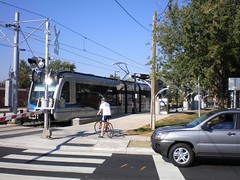
In New York, things got complicated when the Senate passed strong Complete Streets legislation only to see the Assembly severely limit the scope in their version of the bill. Fortunately, a strong coalition of advocates has formed across the state, and the Assembly’s Transportation Committee passed language matching the Senate’s bill. The bill must pass the Assembly Ways and Means Committee before it heads to a full floor vote. With time running out in this legislative session, New Yorkers need to let their Assembly members know this is a priority. Write to them today with this quick form.
Michigan‘s bills continue to move forward as well. After several months of deliberation, the Michigan House of Representatives passed two Complete Streets bills: H.B. 6151, which requires the Michigan DOT to develop a complete streets policy, with a vote of 85–21, and H.B. 6152, which better incorporates complete streets into local master plans, passed with a vote of 84-22. Both bills now await action in the Senate Transportation Committee.
Transportation Secretary Ray LaHood took some time to discuss how the DOT’s work to improve the quality of life for all Americans also includes the folks over 50 – consistent with AARP’s mission to ensure its members have good housing choices with good options to get where they need to go.
This message isn’t lost on Albert Lea, Minnesota. AARP chose this community as a prototype “Blue Zones” community, where various strategies and policies were enacted to make sure people of all ages and abilities can live long, healthy lives – including the adoption of a Complete Streets ordinance. As a result, the city is beginning to plan its very first bike lane.
In New York City, Mayor Bloomberg was recently lauded by AARP for his initiatives to make the Big Apple a World Health Organization Age-Friendly City. In fact, it is the first city to be awarded that title. At the event, Linda Gibbs, deputy mayor for health and human services, spoke specifically about the many complete streets transformations that have created safer places for people of all ages and abilities to travel.

Regular transit riders in Charlotte, North Carolina made the news earlier this week for weighing 6.4 pounds less than their driving counterparts. John M. MacDonald, a co-author of the study comparing residents’ weight before and after the introduction of Charlotte’s Lynx light rail line, attributed the weight loss to the walk to and from rail stops. The commuters’ walk, he added, was facilitated by having a safe and attractive built environment.
Work by our Complete Streets Partner firms has gotten attention lately. Kittelson & Associates, Inc. led an international team of experts in preparing the report “Roundabouts in the United States” (.pdf), which was referenced in a recent USA TODAY story. Roundabouts, when designed well, can lead to significant safety improvements for all users.
The San Diego region formally adopted a new methodology for predicting the transportation impacts of development – developed by a team led by Coalition Silver Partner Fehr & Peers. This new tool represents a major departure from a decades old model that has, in part, built the many incomplete streets in our communities. Kaid Benfield has an excellent explanation of how the new model will help create more walkable, bikeable, livable communities.